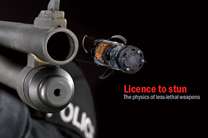Physicists at the center of police weapons testing

In this month's edition of Physics World, David Wilkinson, visiting fellow at Nottingham Trent University and former project manager in the UK Home Office Scientific Development Branch, explains how physics is at the forefront of police weapons testing, making sure that potential devices meet the strict criteria set out by the UK government.
Modern police weapons, such as CS gas and TASERs, are often referred to as "less-lethal weapons" because they are designed to effectively stop people with minimum risk to both suspects and officers, and are less brutal than traditional options such as truncheons, dogs and guns.
Numerous suggestions for new less-lethal weapons are continually put forward by inventors and commercial companies in the hope of making a considerable profit by placing them in police hands.
In the US, thousands of police forces have broad discretion to buy whatever weapons system they like. In contrast, the UK process is tightly regulated and guided by an operational requirement (OR) -- a list of 22 criteria for analysing the performance of weapons -- which was set out in 2000.
As a result of the OR, physicists find themselves at the centre of the process, sifting through the hundreds of candidates to find the safest and most effective weapons.
Wilkinson uses TASERs as a case study to demonstrate the extensive scientific testing that these weapons undergo, explaining how high-speed cameras were used to test the speed and trajectory of the darts, 3D computer models were used to trace electrical impulses through the body, and how heart tissue was used to test the effect of illegal drugs on hearts exposed to an electrical surge.
A large number of devices, however, fail to make it to the later stages of consideration because they do not meet the most important primary criteria – reliability and minimizing injury and lethality.
A gun that could fire tennis balls at 380 km/h, for instance, is highlighted as an example of a failed device, because the balls rarely hit their target.
As Wilkinson writes, "Before any [weapons] hit the street, politicians, the police and the public will need to discuss their merits and drawbacks. It is important that these discussions are informed by rigorous, physical research."
Provided by Institute of Physics















